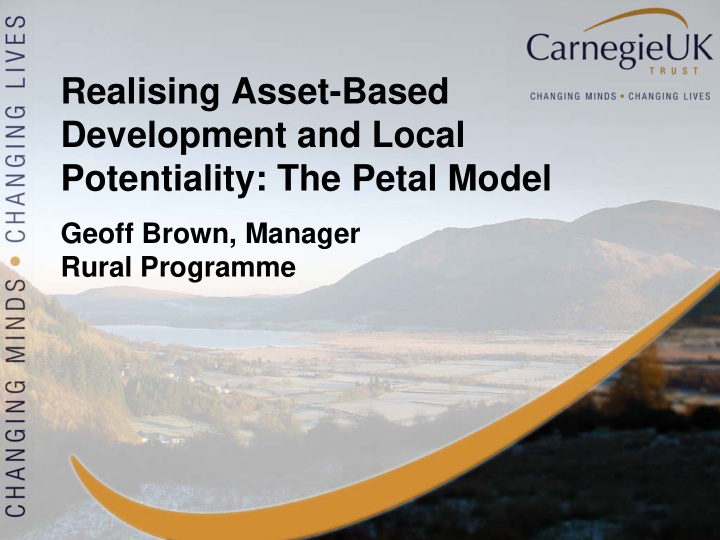



Realising Asset-Based Development and Local Potentiality: The Petal Model Geoff Brown, Manager Rural Programme
Carnegie Commission for Rural Community Development – July 04 to June 07 Challenges and opportunities facing rural communities across the UK and Ireland A CHARTER FOR RURAL COMMUNITIES
GLASS HALF FULL? Building Communities from the inside out (Kretzman and McKnight) Needs, deficiencies and problems OR Commitment to discovering a Community’s capacities and assets
Three main areas for uncovering community assets • Residents • Formal Institutions • Informal organisations located within the Community ‘Once we know the full breadth of people, organisational and institutional resources that exist in a community, we can then move forward in the direction of a needs assessment - In this way as needs are uncovered, there is excellent information about the pool of people and groups who have the type of skills and interests needed to tackle these difficult issues.
The Petal Model: Characteristics of a Vibrant Rural Community These characteristics (petals) need to be seen holistically. They are interdependent, adding value to each other.
• Optimising Assets • Achieving fairness for everyone • Empowering local governance • Increasing financial resources • Enjoying locally relevant services • Enriching social capital and well being • Valuing local distinctiveness • Developing reliable infra-structure • Supporting dynamic local economy • Enhancing environmental capacity
The usefulness of the Petal Model • A Diagnostic tool • A source of ideas • The standards we use and a check on our performance But we need to try it out- suitably modified Looking for volunteers- on top of years of existing practice
The transformation of rural communities will also depend on three enabling factors (leaves) • Realising participative community planning • Growing Capacity • Building Capital
HOW CAN WE USE THE PETAL MODEL? Asset based orientation in general
Optimising Assets • What people have we got? • What skills and gifts do they have? • What is good about this place? • What are our strengths? • What land and buildings do we have? • What meeting places have we got?
Achieving Fairness for everyone •Thinking about all parts of the community of people •Making a commitment to social justice •Equal opportunities, positive discrimination
Empowering Local Governance •Which organisation takes the lead? •Representative and participatory democracy •Do we need new organisations? •Community planning and community action plans
Increasing Financial Resources Responsive grants system but income from activities and enterprise also
Enjoying Locally Relevant Services Essential services should be centrally supplied, but for non-essential services, co-production has great merit: •Social enterprises •Creating services that people need/want locally •Community facilities as multi- service delivery points.
Social Capital and Well-being •Harnessing the rich social capital of many areas; but need access to skilled help •Importance of quality of life indicators
Local Distinctiveness •Place as a focus for development •What’s special about where we live •Harnessing our sense of place •Developing local pride in place •Creating opportunities for sustainable tourism
Developing Reliable Infrastructure •New transport infrastructure (paths, cycle-ways and community transport) •Affordable housing via community land trusts
Dynamic Local Economy •Localisation, food and fuel ‘farming renaissance’ •Eco-system services •What rural areas provide for society as a whole
Enhancing Environmental Capacity Reducing carbon footprint, renewable energy etc The Gigha Story- Faith, Hope and Charity Using asset development and an asset-approach as the basis of wider community (economic) development
Recommend
More recommend